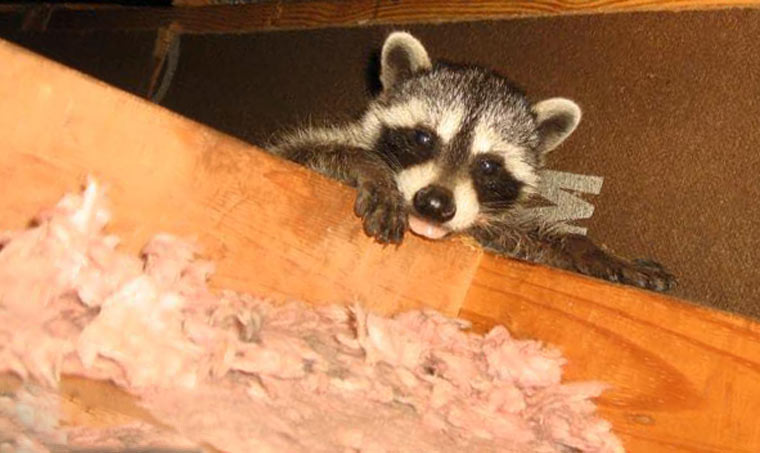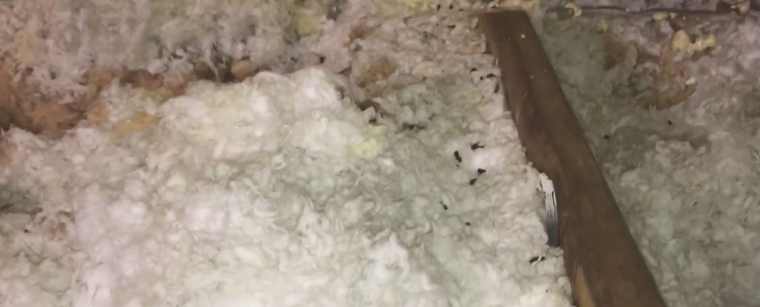-
info@aaanimalcontrol.com
Call us for help in your town
Humane Wildlife Education
How do wild animals in an attic damage insulation?
Need wildlife removal in your hometown? We service over 500 USA locations! Click here to hire us in your town and check prices - updated for year 2020.
Every once in a while it is not uncommon for people to find that wild animals, such as raccoons, birds, squirrels, and other creatures, have found a way to get into their attic area. Because of the seclusion that this area provides, it is not uncommon for animals to seek to create their own homes here. They not only have greater security in areas like your attic, but many people leave memorabilia, old clothing, and blankets there, which make for the perfect nest for a wild animal to use.

However, these materials are not needed because there is something inside the attic that provides the perfect material for an animal to use for its bed. This is the insulation that is used to warm your home.
While it is true that insulation includes fine glass particles as part of the construction of the material, it is also a very warm and comfortable material for an animal to use to create its bed. It makes the perfect nesting material, and this is why animals find it ideal to use. The question then becomes if wild animals damage the insulation in your attic? The truth of the matter is they most certainly do.
There are really two primary ways that an animal can ruin the insulation in your attic. The first of these is by creating the nest itself. If you have roles of insulation that are laid out in the attic area, it is not uncommon for a wild animal to tear this material up to create a more comfortable bed area. Often times, animals, such as squirrels and rats, will dig an area through the insulation sheet where it then creates a kind of cave for it to live in. This makes for a fantastic home.
While this can cause damage to the insulation, the biggest concern that you as a homeowner has is in relation to the waste that these animals give off. Whether you are talking about feces or urine, often times wild animals contain parasites and bacteria that are released when they relieve themselves. This comes out in the feces or urine that they release, which means that it is getting on your insulation at the same time.
By the design of insulation, it is impossible for you to clean this material. In every circumstance, if an animal like this has relieved itself on your insulation you must throw it away right away. Otherwise, you are giving room for parasites, bacteria, fungus, and other kinds of pathogens to blossom in your home and create a serious health risk for you and your family. Because of the warm temperatures in your attic, it is a fertile breeding ground, especially for bacteria, meaning that you are putting yourself at a huge risk if you don't simply get rid of this material.
It is true that this will be costly to replace insulation, but that is well worth the cost in relation to what it can mean to your health.
Do rats destroy insulation in an attic?
Need rodent removal in your hometown? We service over 500 USA locations! Click here to hire us in your town and check prices- updated for year 2020.
In a word, yes, rats do destroy insulation in an attic, and it could be for far more reasons than you first thought. We all know that rats chew through stuff and build nests in your attic, so it's a safe assumption to believe that the rodents are chewing through, stealing, and moulding some of your insulation material into a cosy enough bed to rear babies in. That's not all though. Rats also defecate all over the place, quite literally peeing and pooping wherever they run. Any attic insulation that could have been touched by a rat, if only by one touch of a paw, could potentially have traces of rat urine or feces on it too. These are not only pretty disgusting to think about, but are also dangerous in terms of disease, could smell pretty bad after a while, with a smell that increases in intensity the more rats you have and the more they are left to pee and poop all around, and finally, could even signal to other rats. Pheromones are present in the urine of these rodents, and these pheromones are what the little beasts use to communicate with each other. You won't be able to sense or smell these pheromones, but the rats can. And if they can still smell it, they will still try to come closer. If you don't clean up properly after a rat infestation, you are leading the way for more rats to come right on it. Those pheromones are just telling other rats that there is plenty of food, water, and shelter at your house.

Not just containing pheromones that are used to communicate with other rats, the urine and feces left behind by these rodents could potentially be dangerous for you, your other family members, and maybe even your household pets.
One of the most dangerous diseases ever carried and transmitted by rats has got to be the bubonic plague, which many of us will know more simply as the ‘Black Plague'. The disease is worthy of its dismal-sounding name too, killing millions of people and wiping out entire generations during the Middle Ages. It wasn't actually the rat that was responsible for the apocalyptic-style disease, but rather the fleas that were on these rats. If your attic or attic insulation has been infested with fleas, don't automatically assume that your pampered pooch or feline friend is responsible. There is a chance that rats or mice could have invited the hopping bugs to the party. There is also still the chance that a bubonic plague breakout could still occur. Although many people consider the disease to be almost extinct, there are still flare-ups of it from time to time, and this is across the world too, not always just in the developing countries, as you would perhaps expect. During the 1900's, the "Black Plague" still killed millions, but it wasn't in one big hit as it was seen in the Middle Ages. Better levels of hygiene in human areas have prevented the disease from becoming too much of a problem, thankfully, but it is still a very major concern all the time that rats are hanging around.
Going back to rat urine again, which we're sure you didn't anticipate researching today, and that alone can be responsible for the spread of disease. This threat can be present long after the rats have actually been removed from the building, as is the case with Leptospirosis. This is a disease commonly spread through the urine of wild animals, including rats, and in worst case scenarios could even result in permanent and fatal damage to the major organs, including the kidney and liver. Even more frighteningly, just unsafe handling the urine and feces left behind by wild animal invaders is enough to pass the disease along to humans.
LCMV, also known as Lymphocytic Choriomeningitis, is a viral infection, borne by rodents. The house mouse is the most prolific offender, but all rodents, including rats, can carry and transmit this disease, which can be every bit as scary as the name would lead you to believe. Recent studies seem to suggest that as much as five to ten percent of all house mice could be carrying the virus that causes LCMV. Sadly, these studies are very difficult to piece together as many cases go unreported.
Just like Leptospirosis, LCMV is passed on via the urine of infected animals, like rats. It's not just the urine that is responsible either, nesting materials, saliva, and even rat fences have all been shown to contain the spores that cause this infection.
For more information, you may want to click on one of these guides that I wrote:
How much does rat removal cost? - get the lowdown on prices.
How to get rid of rats - my main rat removal info guide.
Example rat trapping photographs - get do-it-yourself ideas.
Rat job blog - learn from great examples of rat jobs I've done.
rats in the attic - the steps to get them out.
Rats in the walls - what to do to solve the problem.
For more information, you may want to click on one of these guides that I wrote:
How To Guide: Who should I hire? - What questions to ask, to look for, who NOT to hire.
How To Guide: do it yourself! - Advice on saving money by doing wildlife removal yourself.
Guide: How much does wildlife removal cost? - Analysis of wildlife control prices.
Animals in the attic - read about the common species.
Noises in the attic - how to identify critters by their sounds.


















